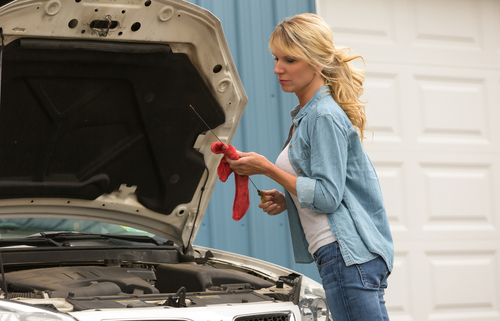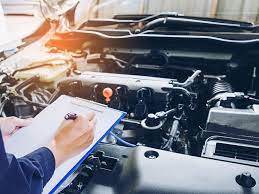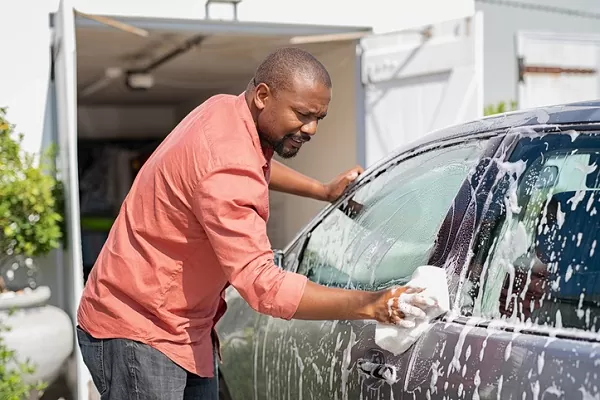How To Do Basic Car Maintenance For Women

How to do basic car maintenance for women – Gone are the days when car maintenance was considered a predominantly male domain. Today, women are taking the wheel and embracing the responsibility of caring for their vehicles. Understanding basic car maintenance not only saves time and money but also empowers women to take control of their driving experience. Embracing car maintenance as a woman challenges gender stereotypes and inspires others to do the same. By taking charge of your vehicle’s maintenance, you set an example for other women, encouraging them to develop their skills and knowledge in this traditionally male-dominated field.

Learning how to perform basic car maintenance is important for women to gain independence, save money, ensure safety, and build confidence. By understanding your vehicle, performing routine maintenance tasks, and being proactive, you can enjoy a reliable and well-maintained car while breaking barriers and inspiring others. Embrace the opportunity to learn and empower yourself in the world of car maintenance, and enjoy the benefits it brings to your driving experience.
Read Also: How To Do Basic Car Maintenance For Beginners
Empowering Women: A Comprehensive Guide to Basic Car Maintenance
This comprehensive guide will walk you through essential car maintenance tasks that every woman should know. Whether you’re a new driver or looking to expand your knowledge, these basic car maintenance tips will equip you with the skills and confidence to keep your vehicle running smoothly and safely.enoughinfo
1. Getting to Know Your Car
Before diving into car maintenance, it’s important to familiarize yourself with the different parts and systems of your vehicle. Understanding the basics of your car will help you identify and address issues more effectively. Here’s what you should know:
- Know your car’s components: Learn about the engine, battery, tires, brakes, fluids, and electrical system. Understand their functions and how they contribute to the overall operation of your vehicle.
- Read the owner’s manual: The owner’s manual provides valuable information about your specific car model, including recommended maintenance schedules, fluid capacities, and troubleshooting tips. Keep it handy as a reference guide.
2. Essential Car Maintenance Tasks

In this section, we will cover the basic car maintenance tasks that every woman should be familiar with. These tasks will help you keep your car in good condition and prevent potential issues. Here’s a breakdown of the essential tasks:
Checking and Topping Up Fluids: Learn how to check and refill essential fluids such as engine oil, coolant, brake fluid, power steering fluid, and windshield washer fluid. Understand the proper fluid levels and how to identify potential leaks.
Battery Care: Know how to inspect the battery for signs of corrosion, clean the terminals, and ensure proper connections. Learn how to jump-start a dead battery and when to replace it.
Tire Maintenance: Understand how to check tire pressure, how to properly inflate tires, and when to rotate them. Learn how to inspect tires for wear and tear and how to identify signs of potential problems.
Changing A Flat Tire: Know how to safely change a flat tire using a jack, lug wrench, and spare tire. Practice the steps in a controlled environment before needing to do it on the roadside.
Brake Inspection: Understand the signs of worn-out brake pads and how to inspect them. Learn when to replace brake pads and how to recognize other brake-related issues.
Replacing Windshield Wipers: Know how to replace worn-out windshield wiper blades to ensure clear visibility during inclement weather.
Changing Engine Air Filter: Learn how to locate and replace the engine air filter to maintain proper airflow and engine performance.
Replacing Headlights and Taillights: Understand how to replace faulty headlights and taillights to ensure proper illumination and road safety.
Read Also: How To Do Basic Car Painting (All You Need To Know)
3. Basic Troubleshooting and Emergency Preparedness
In this section, we will cover basic troubleshooting techniques and emergency preparedness tips to help you handle common issues on the road:
- Understanding Warning Lights: Familiarize yourself with common dashboard warning lights and their meanings. Learn how to respond appropriately when a warning light illuminates.
- Dealing with Common Issues: Learn how to troubleshoot common problems such as a dead battery, overheating, or a malfunctioning engine. Understand when to seek professional assistance.
- Creating an Emergency Kit: Prepare an emergency kit containing essential items such as a flashlight, jumper cables, basic tools, a first aid kit, and a roadside assistance contact number.
- Roadside Safety: Know how to safely pull over to the side of the road in case of an emergency. Understand the importance of visibility and using hazard lights.
4. Seeking Professional Assistance
While it’s empowering to be knowledgeable about basic car maintenance, there are times when professional assistance is necessary. In this section, we highlight when it’s best to rely on the expertise of a trusted mechanic:
- Complex Repairs: For more complicated repairs or maintenance tasks, it’s advisable to seek professional help. This ensures that the job is done correctly and efficiently.
- Regular Maintenance: Some maintenance tasks require specialized equipment or knowledge that may be better suited for a professional. Examples include wheel alignment, transmission servicing, and comprehensive inspections.
- Warranty Considerations: If your vehicle is under warranty, it may require maintenance and repairs to be performed by authorized service centers to maintain warranty coverage. Be aware of any warranty stipulations and requirements.
Read Also: How To Do Basic Car Detailing
FAQs & Answers
Q: How often should I check my car’s fluids?
A: It is recommended to check your car’s fluids regularly, about once a month. This includes checking the engine oil, coolant, brake fluid, power steering fluid, and windshield washer fluid. However, it’s important to consult your vehicle’s owner’s manual for specific recommendations regarding fluid checks and maintenance intervals.
Q: What should I do if my car’s battery dies?
A: If your car’s battery dies, you can jump-start it using jumper cables and another vehicle with a functional battery. Connect the positive (+) and negative (-) terminals of the two batteries with the corresponding jumper cables. Start the engine of the vehicle with the functional battery and let it run for a few minutes. Then, try starting your car. If it doesn’t start, you may need to replace the battery or seek assistance from a professional.
Q: How do I know when it’s time to replace my tires?
A: There are several indicators that it may be time to replace your tires:
- Tread wear indicators: Check for tread wear indicators, which are raised bars located in the grooves of your tires. If the tread has worn down to the same level as these indicators, it’s time to replace the tires.
- Tread depth: Measure the tread depth using a tread depth gauge or a coin. If the tread depth is below the recommended level (generally 2/32 of an inch or less), it’s time to replace the tires.
- Visible damage: Inspect the tires for any visible signs of damage, such as cuts, bulges, or cracks. These can indicate tire failure and require immediate replacement.
- Age: Even if the tires have sufficient tread, it is recommended to replace them if they are over six years old as rubber can degrade over time.
Q: How often should I change my engine air filter?
A: The engine air filter should typically be replaced every 12,000 to 15,000 miles (or as recommended by your vehicle’s manufacturer). However, if you frequently drive in dusty or dirty conditions, you may need to replace it more frequently. It’s important to check the filter regularly and replace it if it appears dirty or clogged.
Read Also: How To Unlock A Car Door With Power Locks
Q: What should I do if a dashboard warning light comes on?
A: When a dashboard warning light illuminates, it’s important to address it promptly. Consult your vehicle’s owner’s manual to understand the meaning of the specific warning light. In some cases, it may be a minor issue that you can resolve yourself, such as low tire pressure. However, for more complex or serious problems, it’s best to seek professional assistance from a qualified mechanic to diagnose and resolve the issue.
Q: Can I perform my own wheel alignment?
A: Wheel alignment is a complex task that requires specialized equipment and knowledge. It is recommended to have wheel alignments performed by a professional. Improper wheel alignment can result in uneven tire wear, poor handling, and decreased fuel efficiency. A professional mechanic can ensure accurate alignment and proper adjustment based on your vehicle’s specifications.How to do basic car maintenance for women
Q: What should I include in my emergency kit for the car?
A: An emergency kit for your car should include essential items such as:
- Flashlight and extra batteries
- Jumper cables
- Basic tools (screwdriver, pliers, adjustable wrench)
- First aid kit
- Reflective warning triangle or roadside flares
- Blanket or extra clothing
- Drinking water and non-perishable snacks
- Emergency contact numbers, including roadside assistance
Q: Can I perform all car maintenance tasks by myself?
A: While many basic car maintenance tasks can be performed by individuals with some knowledge and practice, there are certain tasks that require professional expertise and specialized equipment. Complex repairs, electrical work, and some maintenance tasks may be best left to professional mechanics. Additionally, if your vehicle is under warranty, following the manufacturer’s recommended maintenance schedule and having work done by authorized service centers may be necessary to maintain warranty coverage.
Read Also: How To Do Basic Car Repairs(Ultimate Guide)
Conclusion
Equipping yourself with knowledge of basic car maintenance is a powerful tool for women drivers. By understanding your vehicle’s components, performfing essential maintenance tasks, troubleshooting common issues, and being prepared for emergencies, you can confidently take charge of your car’s well-being. Remember, practice and experience will further enhance your skills over time. Embrace the opportunity to learn and empower yourself in this traditionally male-dominated field. With the information provided in this guide, you can navigate the road with confidence, ensuring your car runs smoothly and safely for many miles to come.



